 Artwork by 2022 Art Contest Winner Simone L. (Grade 1, Michigan).
Sharing complex ideas like plastic pollution and marine debris with younger students can sometimes be challenging. Here are some tips if you’re hoping to introduce marine debris to young students:
- Engage the senses! Try using touch to experiment with different kinds of marine debris. Can you tell the difference between natural and human-made items? Which ones do you think will float or sink? How could this impact the environment based on how it feels?
- Get creative! Providing students with opportunities to color, draw, or make sculptures of marine debris helps engage students with different learning styles to learn and problem-solve around the issue of marine debris.
- Keep it positive! Marine debris is a big problem that has some pretty sad impacts on our world, like entanglement or ingestion. By focusing on solutions and working as a community to make a difference, students will walk away empowered by knowing how they can help!
At the NOAA Marine Debris Program, we have a few great ways to help young students understand marine debris. Check out these activities and lesson plans, just for students in third grade and younger!
For more activities perfect for young students, check out the crafts at the end of this newsletter! Work together to reuse old egg cartons and create colorful ecosystems.
Enthusiastically,
Alexandria Brake, Education Specialist
 Check out the full 2021 Accomplishments Report on our website!
The NOAA Marine Debris Program is proud to present our 2021 Accomplishments Report. Once a year, we like to take a moment to reflect on our Program’s mission to investigate and prevent the adverse impacts of marine debris, and to recognize the achievements made by our team and our partners. Despite continued obstacles during this difficult period, the NOAA Marine Debris Program and partners adapted and expanded our efforts to achieve the ambitious goals set in our new strategic plan.
Learn more
 Explore the complex issue of microplastics in the classroom through these inquiry-based lessons (Credit: Blue Ocean Society for Marine Conservation).
Microplastics, or plastic particles smaller than 5mm, and the closely related microfibers might be small in size, but they have a huge impact on our environment. Through a partnership with the NOAA Marine Debris Program and National Marine Sanctuary Foundation, Rozalia Project for a Clean Ocean and Blue Ocean Society for Marine Conservation created two engaging, hands-on lessons to explore the critical issue of microplastics and microfibers. These inquiry-based lessons provide students with practice in the scientific method, as well as an understanding of plastic pollution research and action.
Learn more
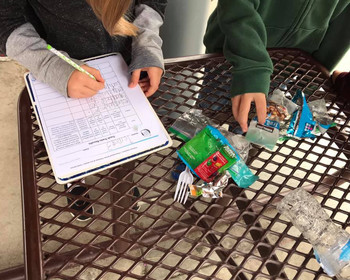 Students with One Cool Earth, highlighted in the NOAA Education Accomplishments Report, completed projects like waste audits and composting to prevent marine debris in their community (Credit: One Cool Earth).
NOAA takes an “all hands on deck” approach to education. Our educators and partners work in different offices, programs, states, and even countries, covering topics that span from the surface of the sun to the depths of the ocean. NOAA Education reaches preschoolers through retirees both inside and outside the classroom. This report highlights some of the many accomplishments that the NOAA Education Council and broader NOAA Education community completed in fiscal year 2021, including one of the NOAA Marine Debris Program’s wonderful partners, One Cool Earth.
Learn more
 Derelict fishing nets are just one of the many ways marine debris can impact coral reef ecosystems (Credit: NOAA).
Coral reefs are one of the most important ecosystems on our planet that protect and foster biodiversity. The diversity of locations and reef types makes this system unique and allows for valuable comparisons of reefs from differing biogeographic regions and of differing levels of use. Explore this collection of NOAA webinars, lesson plans, posters, videos, infographics, virtual reality, and more learn about coral reef ecosystems and NOAA Office of National Marine Sanctuaries’ efforts within the sanctuary system to preserve them and limit the impacts they face. There’s also a webinar tomorrow, February 24, to learn more about the Coral Check-Up Lesson Series with Papahānaumokuākea Marine National Monument staff.
Learn more about this and other Resource Collections from the NOAA Office of National Marine Sanctuaries.
Learn more about how marine debris can impact fragile coral reef ecosystems and other important habitats with Discover Marine Debris!
 Help us meet your multimedia needs! (Credit: NOAA)
The NOAA education community recognizes that today educators and students are using live and on demand multimedia content to learn about ocean, atmospheric, climate, and related STEM topics, as well as access education and pedagogic resources and training. In developing multimedia and distance learning materials that convey NOAA’s mission of science, service, and stewardship, NOAA must insure that these resources meet the needs of educators and students across the United States. To achieve this goal, we need your help. This short (less than 5 minute) survey will help NOAA identify the types of multimedia content that interests you for use with your students/audiences as well as your own professional development. Your participation is voluntary and your answers completely anonymous. Thank you for your time.
Learn more
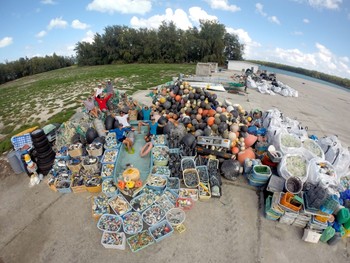 How much of this debris could have been interrupted before it washed up in Papahānaumokuākea Marine National Monument? (Credit: NOAA)
Have you ever found something on the beach and wondered what it was? In this free online Oregon Sea Grant workshop, educators will be introduced to lessons that help students learn the story of a particular type of marine debris and identify ways to interrupt the path that led it to be discarded or abandoned in the ocean. Explore lessons and resources, and hear from a teacher who has implemented activities with her students.
Learn more
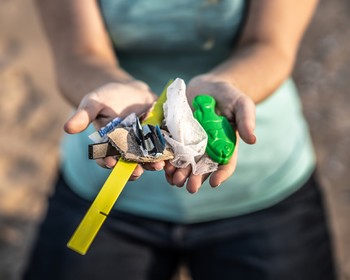 Picture this debris turned into art to raise awareness about the issue of marine debris (Credit: Rick Houchin Photography).
In order to help raise awareness of the issue of marine debris in the Great Lakes, we’re excited to be offering the Ohio Marine Debris Art Challenge for students in grades 6-12 in coastal Ohio! After learning about marine debris in the ocean and Great Lakes, and how we all may be contributing with our trash, students will create marine debris artwork from repurposed trash.
Learn more
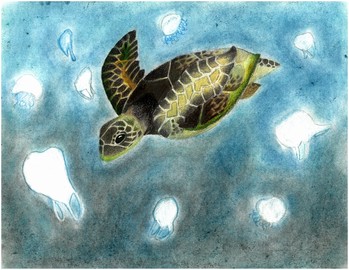 Artwork by Sophie W. (Grade 8, Michigan).
Celebrate Endangered Species Day (May 20) by having your classroom participate in the Greater Atlantic Regional Fisheries Office 2022 Marine Endangered Species Art Contest! Endangered and threatened species need our help. Students’ artwork will showcase their knowledge and commitment to protecting these animals. Artwork should highlight one or more marine endangered or threatened species from the New England/Mid-Atlantic region.
Learn more
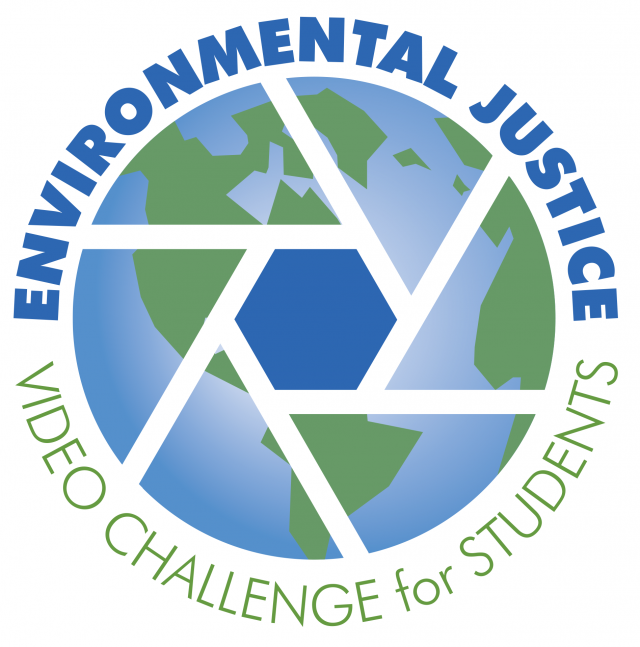 Students can use their creativity to highlight environmental justice issues and enhance their communities' capacity to address inequities (Credit: U.S. Environmental Protection Agency).
Many communities face greater environmental exposures and public health risks due to a history of inequitable environmental policies and access to the decision-making process. Environmental justice is the fair treatment and meaningful involvement of all people regardless of race, color, national origin, or income, with respect to the development, implementation, and enforcement of environmental laws, regulations, and policies.
The U.S. Environmental Protection Agency and partners have launched the Environmental Justice Video Challenge for Students to enhance communities’ capacity to address environmental and public health inequities.
Learn more
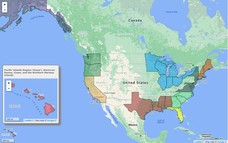
Check out some features from our projects around the country working to prevent marine debris.
|
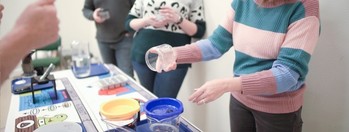 Participants learn about marine debris science during a hands-on workshop (Credit: Wisconsin Sea Grant).
Wisconsin Sea Grant's The Play’s the Thing project will use the power of storytelling and performance to engage, educate, and inspire performing artists, students, and community members to be committed stewards of their Great Lakes watershed. The project includes theatrical performances about marine debris science, outreach and education activities with a fine arts school, on-site cleanup events, and marine debris prevention stewardship activities related to prevention of land-based marine debris and prevention of microplastics in wastewater.
Learn more
 Volunteers make their way to a cleanup at the Tijuana River National Estuarine Research Reserve (Credit: Surfrider Foundation).
In the Tijuana River Valley, the Southwest Wetlands Interpretive Association and Tijuana River National Estuarine Research Reserve are repurposing and upcycling debris items to prevent and remove marine debris from the Tijuana River watershed and Pacific Ocean. Partners are piloting a community-led circular economy by upcycling and selling items made from marine debris. A cross-border Marine Debris Leadership Academy for local U.S. and Mexican leaders, organizations, and groups is being formed to increase discussions around marine debris solutions.
Learn more
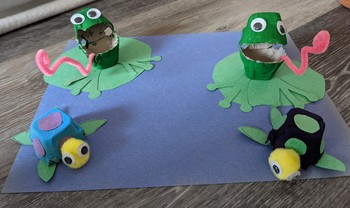 No marine debris in this pond! (Credit: NOAA)
March 3 is World Wildlife Day! Once it's in the environment, marine debris can have significant impacts on wildlife. Some wildlife can get tangled up in debris, while others can accidentally swallow debris. Some debris can also damage habitats or transport non-native species into new areas.
Get ready to celebrate World Wildlife Day by creating an ecosystem out of repurposed egg cartons! This fun craft is appropriate for all ages, but will be especially engaging for younger students.
Looking for a craft from a previous newsletter? Check out our NOAA Marine Debris Program Newsletter Archive page to revisit all of our past activities (including the flowers featured in this ecosystem!).
Don't Let Debris "Bug" You!
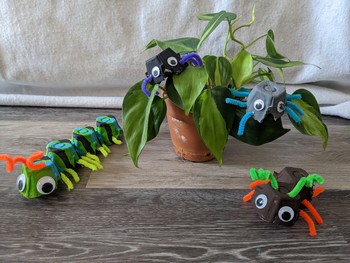 Learn about many different creatures and their niche in the environment with this fun craft, all while preventing marine debris (Credit: NOAA).
To make my ecosystem, I crafted a few different creatures and plants, but you and your students can focus on just one or create even more!
Supplies Needed:
- Egg cartons (either plastic or cardboard will work)
- Scissors
- Glue
- Paint & brushes
- Construction paper
- Googly eyes
- Pipe cleaners
- Pom-poms
Steps:

1. Cut the egg cartons into pieces. You can cut all kinds of different combinations. One spot for bugs, turtles, and frogs, two spots for ants, and longer ones for caterpillars or worms. I also cut 2x2 squares to make flower blossoms.
|
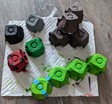
2. Paint your creatures however you want!
Note: Depending on how much paint you use, it may need to dry overnight.
|

3. While the paint dries, cut out construction paper pieces. I made a stem for the flowers, lily pads (not pictured), feet for the frogs, and spots and fins for the turtles. You can also craft tree trunks, grass, water, or whatever else you want in your ecosystem!
|

4. Glue on your googly eyes, pom-poms, fins, or anything else!
Note: To make the frogs, I glued two spots together on one edge, making a kind of hinge to open their mouths.
|

5. Cut holes in the top and bottom of the bugs for antennae and legs.
Note: If you are using scissors, this should be done by adults. You can also use a hole-puncher.
|
6. Set your creatures free!
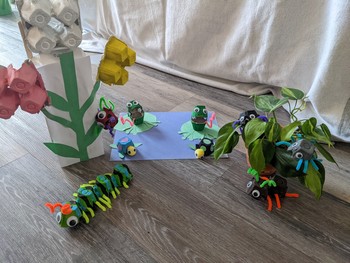 Voila! A whole ecosystem can come to life with repurposed egg cartons (Credit: NOAA).
Interested in more ways to help prevent marine debris at home, at school, or at the store? Dive into all kinds of ideas on our How to Help page.
Have any feedback on our content?
Please reach out and contact us if you have any questions, ideas, or hopes for our marine debris materials.
Contact us at marinedebris.web@noaa.gov
Subscribe to the NOAA Marine Debris Program Education Newsletter
Subscribe to the NOAA Marine Debris Program Monthly Newsletter
Subscribe to the Marine Debris Blog
|